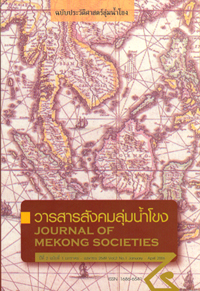Review Article: Fundamental Understanding about Angkor
Main Article Content
Abstract
According to the document review about Cambodian studies in Thailand during September 2005 and March 2006, there are some studies focusing on Angkor, which includes a number of studies of stone historic sites and the most periods that were likely to build the sites (approximately in 9-13 A.D.) As a beginner of learning on Cambodian issues, I try to organize the related studies on Angkor to understand the basis about the place. The important questions about the study of Angkor are what factors make this land develop to the great territory; why many huge stone palaces were built during this time; and the factor that led to the end of the regime. The study results are harmoniously in the fact that India is the fundamental influence on the Angkor’s development, especially with the religions. Hinduism, Sivaism, Vishuism and Mahayana Buddhism took turn as a reign’s religion and they were integrated became national uniqueness differently from Indian’s. Due to the fact that Cambodia is rich of the technical advancement along with the local arts, the Davaraia had been developed in this country. There are two different assumptions regarding the meaning of “Davaraia.” Some believe that it is the faith of raising the king’s status to be God whereas some believe that it is the worship of the king’s of all Gods. However, the unconcluded point of view beyond this issue is about the king’s authorities and his roles under the Davaraia. The concern is whether the king’s authorities in each province is the centralized power or many powers that involved with each other by relative relationship and client relationship. However, to build enormous stone palace or religion place are all the symbol of God’s supportive as a great king. Additionally, the study results found that women had an important role behind the ascension of many kings in the past. Besides Davaraia, water partitions and channels appear close to each palace is another considered factor of the development to the great empire. It is assumed basing on Asian production that this is an agricultural irrigation, which could help growing rice three to four times a year to which making huge extra products to feed the population. Moreover, the culture of building water partitions and channels is also the cause of the need in organizing more social orders. With this reasons, there are variety levels in the society which are able to build up many large religion places and this is also a significant reason of the final stage of the Angkor after the irrigation failure. Nevertheless, there are some argument studies to the above agricultural issues said that the reservoirs in Angkor were for consumption, utilization and some rituals about Cosmology and the king’s power. The study of the Angkor’s deterioration demonstrated on the termination of building the stone palace and moving the capital city out from Angkor led to the three assumptions. The three understandings are the war with Ayuthaya; the failure of the irrigation system; and the exhaustion in building the stone palace and the change to belief in Theravada Buddhism. Although many studies concluded that they are mutual factors, some stressed on some factors that is meant to be more important than others. In addition to the studies of Angkor’s history, there are also some interesting studies on the Cambodian’s remembrance of Angkor. These studies reflect the memory maintenance through the Leper King legend; the remembrance trail on Angkor before acknowledging from French; the historical context in secondary and higher educational schools textbooks, which is the basic memory of the present; and the consideration of Angkor as a symbol of the “nation.”

